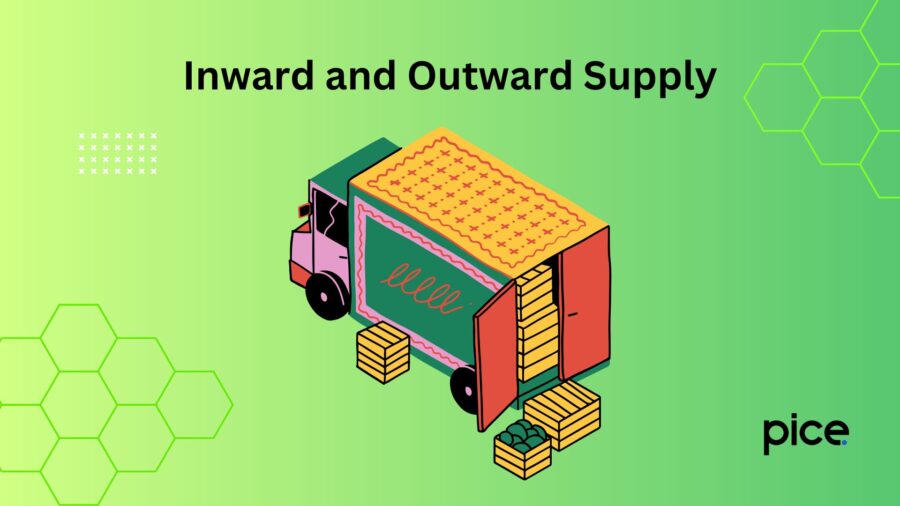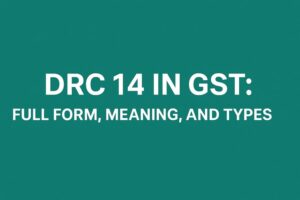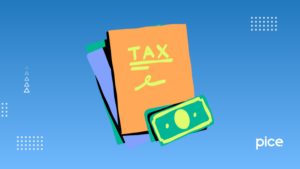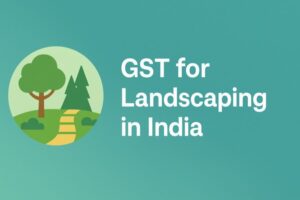Inward and Outward Supply in GST: A Detailed Overview
- 16 Dec 24
- 14 mins

Inward and Outward Supply in GST: A Detailed Overview
Key Takeaways:
- Inward supplies involve the receipt of goods or services for business purposes, while outward supplies refer to their sale or transfer.
- Input Tax Credit (ITC) can be claimed on inward supplies to offset GST liability on outward supplies.
- Inward supplies are declared in GSTR-2, while outward supplies are reported in GSTR-1 or Annexure-1.
- Inter-state and intra-state movements of goods classify as inward or outward supplies based on their direction.
- Proper classification and reporting of supplies help businesses reduce their GST burden efficiently.
Inward and outward supply in GST (Goods and Services Tax) are classifications of supply based on the movement of goods. These are crucial components under the GST structure that determine the respective return filing methods for business owners. While inward supplies refer to purchases, outward supplies refer to the sale of goods and services. Here is what these are in detail to help you make informed decisions pertaining to GST filing.
Handle all your sales and purchase invoices in one place.
Pice’s all-in-one invoice management tool helps you track, send, and organize invoices from a single dashboard. Automatically share new invoices with customers, send timely payment reminders, and keep your collections under control—effortlessly.
Want early access? Fill out this form to get request a demo!
Understanding Inward Supply in GST
To understand inward supply in GST, find below what it constitutes, its impact on input tax credit and its examples:
What Constitutes Inward Supply?
Under Section 67, inward supply refers to the receipt of goods or services or both by purchase, acquisition or other means for furtherance of businesses. A registered taxpayer needs to furnish the item details of inward supplies received during the current tax period after the 10th of the month succeeding the tax period but before the 15th, as per the Section 38(2).
The details of inward supplies need to be furnished in Form GSTR-2. Here are the factors that need furnishing:
- Details of inter-state and intra-state supplies received from a registered or a non-registered person across all previous invoice and original invoice details
- Import of goods or services or both
- If debit notes or credit notes are received from a supplier of services or goods
How to Declare Inward Supplies in GSTR-2?
Given below is a detailed list of all the headings in Form GSTR-2 where you need to declare inward supplies under GST:
| Sections | Description |
| Part 1 | GSTIN |
| Part 2 | Name of the taxpayer |
| Part 3 | Inward supplies received from a registered person other than the supplies attracting reverse charge |
| Part 4 | Inward supplies on which tax is to be paid on reverse charge |
| Part 5 | Inputs/Capital goods received from Overseas or from SEZ units on a Bill of Entry |
| Part 6 | Amendments to details of inward supplies furnished in returns for earlier tax periods in Tables 3, 4 and 5 [including debit notes/credit notes issued and their subsequent amendments] |
| Part 7 | Supplies received from composition taxable person and other exempt/Nil rated/Non GST supplies received |
| Part 8 | ISD credit received |
| Part 9 | TDS and TCS Credit received |
| Part 10 | Consolidated Statement of Advances paid/Advance adjusted on account of receipt of supply |
| Part 11 | Input Tax Credit Reversal / Reclaim |
| Part 12 | Addition and reduction of amount in output tax for mismatch and other reasons |
| Part 13 | HSN summary of inward supplies |
How Inward Supply Impacts Input Tax Credit (ITC)?
Input tax credit (ITC) is the GST that a registered taxpayer pays for buying goods or services for business continuity and growth. If the goods and services are used for business purposes, the registered person can claim ITC on the inward supplies of goods and services.
For instance, a manufacturer purchases raw materials worth ₹10,000 at an applicable tax rate (GST rate) of 18%. Then the manufacturer can claim ₹1,800 (18% of ₹10,000) as input tax credit on inward supplies of goods and services.
Further, if the manufacturer sells goods and services worth ₹15,000, thereby collecting a GST of ₹2,700, then he/she can use the ITC to offset the outward tax liability. He/she will have to pay only ₹900 as GST liability.
💡 If you want to pay your GST with Credit Card, then download Pice Business Payment App. Pice is the one stop app for all paying all your business expenses.
However, if the purchases are used for non-business purposes or personal human consumption, the manufacturer cannot claim ITC for the inward supplies of goods and services. Thus, inward supplies allow manufacturers to reduce the tax liability and tax burden with the condition that the goods or services are used for the furtherance of business.
Examples of Inward Supply
Inward supply includes both inter-state and intra-state supply of goods and services. For instance, a supply of goods and services between Kolkata, in West Bengal and Bardhaman in West Bengal is an intra-state inward supply. On the other hand, a supply of goods and services between Kolkata in West Bengal and Ranchi in Jharkhand is an example of inter-state inward supply.
Exploring Outward Supply in GST
Here is what outward supply in GST is, followed by its impact on taxpayers’ GST liability and its examples:
Definition of Outward Supply
Under the Central Goods and Services Tax Act (CGST Act), outward supply refers to goods and services supplied by sale, transfer, exchange, license, rental, disposal or lease. In other words, the sale of goods and services for the furtherance of businesses is defined as outward supply.
Outward suppliers play a crucial role in filing GST returns. It helps determine the tax liability of manufacturers and sellers on finished goods when they sell goods and services. In addition, outward supplies and consequent GST collection help manufacturers reduce their output tax liability by claiming input tax credit on inward supplies.
Outward Supply and Its Impact on GST Liability
Reporting outward suppliers of goods and services in GST reduces the tax liability of manufacturers. They can claim credit of input tax on inward supplies to set off output tax liability on outward supplies.
Here is how to report outward supplies in the old GST system:
A registered taxpayer needs to file Form GSTR-1 to declare outward supplies under GST including exports, supplies to Special Economic Zones and inward supplies under the reverse charge mechanism. Additionally, the registered taxpayer has to mention the time of supply corresponding to receipt of advance, if any.
As a registered person, you need to file this form every month for the tax period if your annual turnover exceeds ₹1.5 crore. You need to file this form within the 11th of the following month to declare your outward supplies during the concerned tax period.
However, the process of declaring outward supplies under the new GST system is different. The process is as follows:
A registered person will have to declare outward supplies in Annexure-1 instead of form GSTR-1. All functions of the Annexure will be similar to GSTR-1. Anx-1 will auto-populate the recipient's Anx-2 (Inward Supply Annex). This will assist taxpayers in filing their main return, GST RET-1, enabling them to manage their tax liabilities and claim Input Tax Credit more efficiently within the GST framework.
In addition, taxpayers can easily file their GST annual returns while reducing their output tax liability on outward supplies for previous tax periods. As a supplier, ensure to issue an E-way bill when there is transportation of goods for compliance.
Under the new GST system, taxpayers have been classified into normal and small taxpayers. While normal taxpayers constitute registered persons with an annual turnover exceeding ₹5 crore, small taxpayers consist of registered persons having an annual turnover less than ₹5 crore for payment of taxes.
Normal taxpayers need to upload Annexure-1 and file GST RET-1 monthly while small taxpayers enjoy the benefits of choosing to file returns for outward supplies either quarterly or monthly.
Common Examples of Outward Supply
Examples of outward supplies of goods and services include the sale of goods or services, their transfer or exchange and renting out or leasing goods and services.
How to Declare Outward Supplies in GSTR-1 and Form Anx-1?
Let us begin with the previous tax system where outward supplies are reported in GSTR-1. Below is a detailed list of all the tables in this form.
| Table Number | Table Name |
|---|---|
| Table 4 | Taxable outward supplies made to registered persons |
| Table 5 | Taxable outward inter-state supplies to un-registered persons where the invoice value is more than ₹2.5 lakh |
| Table 6 | Zero-rated supplies and deemed exports |
| Table 7 | Taxable supplies (Net of debit notes and credit notes) to unregistered persons other than the supplies covered in Table 5 |
| Table 8 | Nil rated, exempted and non-GST outward supplies |
| Table 9 | Amendments to taxable outward supply details furnished in returns for earlier tax periods in Tables 4, 5 and 6 [including debit notes, credit notes, refund vouchers issued during the current period and amendments thereof] |
| Table 10 | Amendments to taxable outward supplies to unregistered persons furnished in returns for earlier tax periods in Table 7 |
| Table 11 | Consolidated Statement of Advances Received/Advance adjusted in the current tax period/ Amendments of information furnished in the earlier tax period |
| Table 12 | HSN-wise summary of outward supplies under GST |
| Table 13 | Documents issued during the tax period |
Here is a comprehensive list of all the tables in Form Anx-1 where you are required to report outward supplies under the new GST system:
| Table Number | Table Name |
|---|---|
| Table 3 | Details of outward supplies, inward supplies attracting reverse charge and import of goods and services |
| Table 3 A | Supplies made to consumers and un-registered persons (Net of debit/credit notes) |
| Table 3 B | Supplies made to registered persons (other than those attracting reverse charge) (including edit/amendment) |
| Table 3C | Exports with payment of tax |
| Table 3D | Exports without payment of tax |
| Table 3E | Supplies to SEZ units/developers with payment of tax (including edit/amendment) |
| Table 3F | Supplies to SEZ units/developers without payment of tax (including edit/amendment) |
| Table 3G | Deemed exports (including edit/amendment) |
| Table 3H | Inward supplies attracting reverse charge (to be reported by the recipient, GSTIN wise for every supplier, net of debit/credit notes and advances paid, if any) |
| Table 3I | Import of services (net of debit/ credit notes and advances paid, if any) |
| Table 3J | Import of goods |
| Table 3K | Import of goods from SEZ units/developers on a Bill of Entry |
| Table 3L | Missing documents on which credit has been claimed in T-2 /T-1 (for the quarter) tax period and supplier has not reported the same till the filing of return for the current tax period |
| Table 4 | Details of the supplies made through e-commerce operators liable to collect tax under section 52 |
Difference Between Inward and Outward Supply
The following table illustrates the key differences between inward and outward supplies:
| Parameter | Inward Supply | Outward Supply |
| Definition | Inward supply is the purchase of goods and services for the furtherance of businesses. | Outward supply refers to the sale or transfer of goods and services for business purposes. |
| Difference in Taxation | Manufacturers can claim input tax credits on individual supplies. | Manufacturers can use the input tax credit to offset the output tax liability on outward supplies. |
| Impact on GST return | A registered taxpayer receives a system-generated Form GSTR-2A declaring the inward supplies. | A taxable person needs to file GSTR-1 and Annexure-1 to declare outward supplies. |
| Example | Purchase of intra-state or inter-state goods and services | Sale of taxable interstate or intrastate goods and services |
Classification of Supply Under GST
Under GST regulations, principal supply can be classified in multiple ways. Inward and outward supplies are classifications based on the movement of goods. However, supplies can be classified based on taxability, geographical location and goods supplied in conjunction.
Supply Classification Based on Taxability
The following are the types of supply based on taxability:
- Taxable Supply: Goods and services that attract taxes under GST are a taxable activity of supply.
- Non-taxable Supply: Goods and services that do not attract taxes under GST are non-taxable supplies.
- Exempt Supply: Exempt supply refers to goods and services which attract a nil rate of tax or are completely exempted from payment of tax under Section 11 or Section 6 of the IGST Act (Integrated Goods and Services Act). These further include non-taxable supplies of goods and services.
- Zero-rated Supply: Supply of goods and services in which tax is not payable; however claiming unutilized input tax credit is permitted are zero-rated supplies. The export of services and goods and their supply to Special Economic Zone developers are considered zero-rated supplies.
Supply Classification Based on Geographical Location
Here are the supply classifications based on geographical locations:
- Inter-state Supply: An inter-state transaction refers to the supply of goods and services between two states, two union territories or one state and one union territory. The supply of goods is regulated under Section 7(1) of the IGST Act subject to the provisions of Section 10. On the other hand, the supply of services is regulated under Section 7(3) of the Act subject to the provisions of Section 12.
- Intra- state Supply: Intra-state supplies, resulting in an intra-state transaction, refer to the supply of goods and services within a state or union territory to different locations. Section 8(1) of the IGST Act regulated intrastate supplies of goods and services under GST.
Supply Classification Based on Goods Supplied in Conjunction
When more than one goods or services are supplied, each good or service might exhibit different GST rates. Considering the factor, the supply type includes the following:
Composite Supply:
According to Section 2(30) of the CGST Act 2017, 'composite supplies' refer to a supply made by a taxable person to a recipient consisting of two or more taxable supplies of goods or services that are naturally bundled together and provided as a package in the ordinary course of business. In a composite supply, the items cannot be supplied separately; they must be supplied together, with one being the principal supply while any other items included as ancillary supply.
Mixed Supply:
As per Section 2(74) of the CGST Act 2017, a 'mixed supply' refers to two or more individual supplies of goods or services provided together by a taxable person for a single price, where the supply does not qualify as a composite supply. In a mixed supply, each item can be sold separately.
Conclusion
Inward and outward supply in GST are elements that help taxpayers offset GST liability. You can claim eligible input tax credit on inward supplies while offsetting the output tax liability with the input tax credit as a complete supply chain solution. Thus, the GST burden on purchases and sales of goods and services for business purposes can be offset with appropriate claims based on these two types of supplies.
FAQs
What is inward supply and outward supply in GST?
What is GST on freight inward and outward?
What is 4a, 4b, 4c, 6b, 6c in GSTR-1 format?
4A, 4B, 4C: Taxable outward supplies made to registered persons, including inter-state supplies.
6B, 6C: Zero-rated supplies, such as exports and supplies to SEZ units, with or without payment of tax. These help businesses report specific taxable outward supplies accurately.
 By
By 
















